Phytolacca americana
| Phytolacca americana | |
|---|---|
| | |
| Scientific classification | |
| Kingdom: | Plantae |
| (unranked): | Angiosperms |
| (unranked): | Eudicots |
| (unranked): | Core eudicots |
| Order: | Caryophyllales |
| Family: | Phytolaccaceae |
| Genus: | Phytolacca |
| Species: | P. americana |
| Binomial name | |
| Phytolacca americana L. | |
| Synonyms[1][2] | |
| |
American pokeweed (Phytolacca americana), or simply pokeweed, is a herbaceous perennial plant in the pokeweed family Phytolaccaceae growing up to 8 feet (2 meters) in height. It is native to the eastern United States and has significant toxicity.
It has simple leaves on green to red or purplish stems and a large white taproot. The flowers are green to white, followed by purple to almost black berries which are a food source for songbirds such as gray catbird, northern mockingbird, northern cardinal, and brown thrasher, as well as other birds and some small animals (i.e., to species that are unaffected by its mammalian toxins).
Pokeweed—also known by a number of other names—is native to eastern North America, the Midwest, and the Gulf Coast, with more scattered populations in the far West. It is considered a major pest species by farmers, and that and the danger of human poisoning—its significant toxicity and its risks to human and animal health are consistently reported, with the whole of the plant toxic and increasing in toxicity through the year, with children at particular risk of its very poisonous purple-red ripe fruit—support arguments for eradication of P. americana. Even so, it is used as an ornamental in horticulture, and it provokes interest for the variety of its natural products (toxins and other classes), for its ecological role, its historical role in traditional medicine, and for some utility in biomedical research (e.g., in studies of pokeweed mitogen). In the wild, it is easily found growing in pastures, recently cleared areas, and woodland openings, edge habitats such as along fencerows, and in waste places.
General description
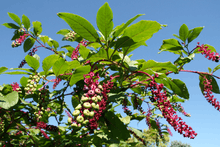
Pokeweed is a member of the Phytolaccaceae, or broader pokeweed family, and is a native herbaceous perennial plant,[3] that is large, growing up to 8 feet (2 meters) in height.[3] One to several branches grow from the crown of a thick, white, fleshy taproot, each a "stout, smooth, green to somewhat purplish stem;" with simple, entire leaves with long petioles alternately arranged along the stem.[3]
Pokeweeds reproduce only by its seeds (large glossy black, and lens-shaped), contained in a fleshy, 10-celled, purple-to-near-black berry with crimson juice. The flowers are perfect, radially symmetric, white or green, with 4-5 sepals and no petals. The flowers develop in elongated clusters termed racemes.[3][4] The seeds have a long viability and can germinate after many years in the soil.
Birds are unaffected by the natural chemicals contained in the berries (see below),[3] and eat them, dispersing the seeds. Seed are also found in commercial seed (e.g., vegetable seed packets).[3] The berries are reported to be a good food source for songbirds and other bird species and small animals unaffected by its toxins.[5] Distribution via birds is thought to accounts for the appearance of "single, isolated plants" in areas that had otherwise not been populated by pokeweed.[3]
Names
P. americana is known as pokeberry,[3][6] poke root,[6] or inkberry,[3] also as Virginia poke or simply poke,[6][7] as pigeonberry,[6][7] or redweed or red ink plant,[7] or, in Chinese medicine, chuíxù shānglù (垂序商陸).[6][8][9] The plant is also referred to as poke sallet or polk salad, and this and related terms can also refer to the cooked leaves of the plant, see Cultural significance below.
Toxicity, poisoning, and mortality
All parts of the plant are toxic and pose risks to human and mammalian health.[10][3][11][12][13] In summary, the poisonous principles are found in highest concentrations in the rootstock, then in leaves and stems and then in the ripe fruit.[10][11] The plant generally gets more toxic with maturity,[10] with the exception of the berries (which have significant toxicity even while green).[13]
Children may be attracted by clusters of berries.[3] OARDC note that[10]
"Children are most frequently poisoned by eating raw berries. Infants are especially sensitive and have died from eating only a few raw berries. Adults have been poisoned, sometimes fatally, by eating improperly prepared leaves and shoots, especially if part of the root is harvested with the shoot, and by mistaking the root for an edible tuber. Research with humans has also shown that common pokeweed can cause mutations (possibly leading to cancer) and birth defects. Since the juice of pokeweed can be absorbed through the skin, contact of plant parts with bare skin should be avoided."
Pokeweed is to be avoided during pregnancy and children consuming even one berry may require emergency treatment[14] The plant sap can cause dermatitis in sensitive people.[14]
Birds are apparently immune to this poison[3] and the plant is not palatable to animals and is avoided unless little else is available, or if it is in contaminated hay, but horses, sheep and cattle have been poisoned by eating fresh leaves or green fodder, and pigs have been poisoned by eating the roots.[10]
Human deaths resulting from pokeweed consumption are uncommon, but cases of emesis and catharsis are known, and a child who consumed crushed seeds in a juice is reported to have died. If death occurs, it is usually due to respiratory paralysis.[3]
Historically, pokeweed poisonings were common in eastern North America during the 19th century, especially from the use of tinctures as antirheumatic preparations and from ingestion of berries and roots that were mistaken for parsnip, Jerusalem artichoke, or horseradish.[15]
Symptoms and response to poisoning
Owen states:[3]
"If taken internally, pokeweed is a slow acting but a violent emetic. Vomiting usually starts about 2 hours after the plant or parts of it have been eaten. Severe cases of poisoning result in purging, spasms, and sometimes convulsions. If death occurs, it is usually due to paralysis of the respiratory organs. Cases of animal or human poisoning should be handled by a veterinarian or a physician."
The OARDC staff scientists note that immediate and subsequent symptoms of poisoning from pokeweed include "a burning sensation in the mouth, salivation, gastrointestinal cramps, and vomiting and bloody diarrhea," and that depending upon the amount consumed, more severe symptoms can occur, including "anemia, altered heart rate and respiration, convulsions and death from respiratory failure."[10] If only small quantities of the plant or its extracts are ingested, people and animals may recover within 1 to 2 days.[10][16]
Habitat and range
Pokeweed also has appeared in Southern Ontario, Canada. Large 8 foot plant appeared 5 years ago and continues to appear regularly every year. If clumps of ripe berries are dispersed about and left over winter, new shoots arrive in the spring and continue to appear every year. Blooms until frost in zone 6. It is unknown if there are any other plants appearing in the Niagara Peninsula.
Owen reports that pokeweed "[u]sually... grows in rich pasture lands, in recently cleared areas, along fencerows, and in waste places and open spots in woodlands."[3] It is broadly distributed in these places and in fields and in edge habitats.
It is adapted to coarse or fine soils with moderate moisture, high calcium tolerance but low salinity tolerance, pH tolerance from 4.7-8. The plant grows well in sun or shade, and readily survives fire due to its ability to resprout from the roots. Pokeweed seeds do not require stratification and are dispersed by berry-feeding birds.
Pokeweed is found in most of the continental United States, except the northern plains and mountain states. In recent years the plant appears to have increased in populated places.[6][17]
Morphology
Plant Type: Perennial herbaceous plant which can reach a height of 10 feet (3 meters), but is usually 4 ft (1.2 m) to 6 ft (2 m). However, the plant must be a few years old before the root grows large enough to support this size. The stem is often red as the plant matures. There is an upright, erect central stem early in the season, which changes to a spreading, horizontal form later in the season with the weight of the berries. Plant dies back to roots each winter. Stem has a chambered pith.
Leaves: The leaves are alternate with coarse texture with moderate porosity. Leaves can reach sixteen inches in length. Each leaf is entire. Leaves are medium green and smooth with what some characterize as an unpleasant odor.
Flowers: The flowers have 5 regular parts with upright stamens and are up to 0.2 inches (5 mm) wide. They have white petal-like sepals without true petals, on white pedicels and peduncles in an upright or drooping raceme, which darken as the plant fruits. Blooms first appear in early summer and continue into early fall.
Fruit: A shiny dark purple berry held in racemose clusters on pink pedicels with a pink peduncle. Pedicels without berries have a distinctive rounded five part calyx. Fruits are round with a flat indented top and bottom. Immature berries are green, turning white and then blackish purple.
Root: Thick central taproot which grows deep and spreads horizontally. Rapid growth. Tan cortex, white pulp, moderate number of rootlets. Transversely cut root slices show concentric rings. No nitrogen fixation ability.[6][14]
Natural products
Various sources discuss notable chemical constituents of the plant.[18] Owen of Iowa State University notes that the "entire pokeweed plant contains a poisonous substance similar to saponin" and that the "alkaloid phytolaccine also occurs in small amounts."[3] Heller at the National Library of Medicine notes the two natural products, the alkaloid phytolaccatoxin and phytolaccagenin, as contributing to human poisoning.[11] The Canadian Poisonous Plants Information System echoes the information about phytolaccine and phytolaccatoxin.[12]
Other toxic components include triterpene saponins based on the triterpene genins, phytolaccagenin as noted, and jaligonic acid, phytolaccagenic acid (phytolaccinic acid), esculentic acid, and pokeberrygenin,[19] and phytolaccasides A, B, D, E, and G, and phytolaccasaponins B, E, and G.[20][21]
Triterpene saponins isolated from the berries of pokeweed uncharacterized as to toxicity include esculentoside E; and phytolaccasides C and F, and oleanolic acid, and 3-oxo-30-carbomethoxy-23-norolean-12-en-28-oic acid.[19] Triterpene alcohols isolated include α-spinasterol and its glucoside, α-spinasteryl-β-D-glucoside, and a palmityl-derivative, 6-palmytityl-α-spinasteryl-6-D-glucoside, as well as a similarly functionalized stigmasterol derivative, 6-palmityl-Δ7-stigmasterol-Δ-D-glucoside.[19]
Other than starch and various tannins, other small molecule natural products isolated from pokeweed include canthomicrol, astragalin, and caryophyllene.[19] Seeds contain the phenolic aldehyde caffeic aldehyde.[22]
Proteins of interest include various lectins, protein PAP-R, and pokeweed mitogen (PWM), as well as a toxic glycoprotein.[12]
Uses
Horticultural and ecological utility
Pokeweed berries are reported to be a good food source for songbirds such as gray catbird (Dumetella carolinensis), northern mockingbird (Mimus polyglottos), northern cardinal (Cardinalis cardinals), and brown thrasher (Toxostoma rufum), other bird species including mourning dove (Zenaida macroura), and cedar waxwing (Bombycilla cedrorum), and small mammals apparently tolerant of its toxins, including raccoon, opossum, red and gray fox, and the white-footed mouse.[5][23]
Pokeweeds are used as sometime food sources by the larvae of some Lepidoptera species, including the giant leopard moth (Hypercompe scribonia).[24]
Some pokeweeds are grown as ornamental plants, mainly for their attractive berries; a number of cultivars have been selected for larger fruit panicles.
Folk and alternative medicine
Owen notes that "Indians and early settlers used the root in poultices and certain drugs for skin diseases and rheumatism."[3]
The late 19th century herbal, the King's American Dispensatory, describes various folk medical uses that led individuals to ingest pokeberry products.[25]
Pokeweed is promoted in alternative medicine as a dietary supplement that can treat a wide range of maladies including mumps, arthritis and various skin conditions.[26] While pokeweed has been subject to laboratory research, there is no medical evidence that it has any beneficial effect on human health.[26]
Food uses
Poke is a traditional southern Appalachian food. The leaves and stems can both be eaten, but must be cooked, usually boiled three times in fresh water each time. The leaves have a taste similar to spinach; the stems taste similar to asparagus. To prepare stems, harvest young stalks prior to chambered pith formation, carefully peel the purple skin away, then chop the stalk up and fry in meal like okra. Traditionally, poke leaves are boiled, drained, boiled again, then fatback is added and cooked some more to add flavor. Poisonings occur from failure to drain the water from the leaves at least once. Preferably they should be boiled, drained, and water replaced two or more times.
As noted by the OARDC staff scientists:[10]
"Children are most frequently poisoned... [and] Infants are especially sensitive and have died from eating only a few raw berries. Although boiled young shoots have been eaten as greens and berries cooked in pie, ingestion of any part of the plant cannot be recommended. Adults have been poisoned, sometimes fatally, by eating improperly prepared leaves and shoots, especially if part of the root is harvested with the shoot, and by mistaking the root for an edible tuber."
Although all parts of the plant are considered toxic and the root is never eaten and cannot be made edible, the late 19th century herbal, the King's American Dispensatory, describes various folk medical uses that led individuals to ingest pokeberry products,[25] and festivals still celebrate the plant's use in its historical food preparations (see below). Authorities advise against eating pokeweed even after thrice boiling, as traces of toxins may still remain, and all agree pokeweed should never be eaten uncooked.
Other uses
Plant toxins from Phytolacca are being explored as a means to control zebra mussels.[27][28]
The toxic extract of pokeweed berries can be processed to yield a red ink or dye.[29]
During the middle of the 19th century wine often was coloured with juice from pokeberries. [30]
Cultural significance
| Nutritional value per 100 g (3.5 oz) | |
|---|---|
| Energy | 84 kJ (20 kcal) |
|
3.1 g | |
| Sugars | 1.6 g |
| Dietary fiber | 1.5 g |
|
0.4 g | |
|
2.3 g | |
| Vitamins | |
| Vitamin A equiv. |
(54%) 435 μg (48%) 5200 μg1747 μg |
| Thiamine (B1) |
(6%) 0.07 mg |
| Riboflavin (B2) |
(21%) 0.25 mg |
| Niacin (B3) |
(7%) 1.1 mg |
| Vitamin B6 |
(9%) 0.111 mg |
| Vitamin C |
(99%) 82 mg |
| Vitamin K |
(103%) 108 μg |
| Minerals | |
| Calcium |
(5%) 53 mg |
| Iron |
(9%) 1.2 mg |
| Magnesium |
(4%) 14 mg |
| Manganese |
(16%) 0.336 mg |
| Phosphorus |
(5%) 33 mg |
| Potassium |
(4%) 184 mg |
| Sodium |
(1%) 18 mg |
|
| |
| |
|
Percentages are roughly approximated using US recommendations for adults. Source: USDA Nutrient Database | |
In music
The cultural significance of poke sallet, the cooked greens-like dish made from pokeweed, and the rural poverty reflected in its history, is indicated by the popularity and coverage received by the 1969 hit swamp rock song "Polk Salad Annie", written and first performed by Tony Joe White.[31][32][33][34] The opening lyrics run:[34][35]
If some of ya'll never been down south too much
I'm gonna tell you a little bit about this
So that you'll understand what I'm talkin' about
Down there we have a plant that grows out in the woods
And in the fields looks somethin' like a turnip green
And everybody calls it polk salad, polk salad
Used to know a girl lived down there
And she'd go out in the evenings and pick her a mess of it
Carry it home and cook it for supper
'Cause thats about all they had to eat, but they did all right....
The song has been covered many times, most famously by Elvis Presley (appearing on several of his albums),[36] by Big Twist and The Mellow Fellows, Tom Jones, Johnny Hallyday, Bill Carlisle, Joe Dassin, and others.[34][37][38]
In local Southern festivals
Poke sallet festivals are held annually in several small southern communities, in remembrance of the plant and its historic role, festivals that have evolved to be local community celebrations only remotely related to the plant as a food or medicinal (e.g.,[39] and individual festival references below). Published locations for the continuing festivals include:
- Arab, Alabama,{{http://www.downtownarab.com}}
- Blanchard, Louisiana, outside of Shreveport[39]
- Gainesboro, Tennessee, 90 miles east-northeast of Nashville, near the Cumberland River[40][41][42]
- Harlan, Kentucky[43]
Nutritional information
Bearing toxicity information in mind (see section above), nutritional information for boiled and drained pokeberry shoots has been reported (see box).
Bearing toxicity information in mind (see section above), nutritional information per 100 grams dry weight of shoots has been reported:[14]
- Protein: 31 g; fat: 4.8 g; carbohydrates: 44 g; fiber: 0 g; ash: 20.2 g
- Minerals - calcium: 631 mg; phosphorus: 524 mg; iron: 20.2 mg; magnesium: 0 mg; sodium: 0 mg; potassium: 0 mg; zinc: 0 mg
- Vitamins - vitamin A: 62 mg; thiamine (vitamin B1): 0.95 mg; riboflavin (vitamin B2): 3.93 mg; niacin (vitamin B3): 14.3 mg; vitamin B6: 0 mg; vitamin C: 1619 mg
Gallery
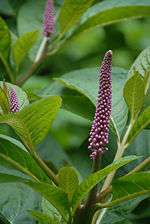
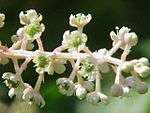
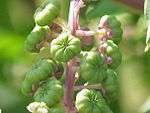
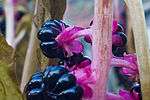
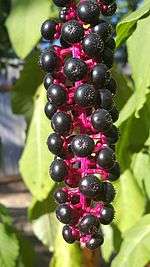
References
- ↑ The Plant List: A Working List of All Plant Species, retrieved 15 August 2015
- ↑ Flora of China online, retrieved 15 August 2015
- 1 2 3 4 5 6 7 8 9 10 11 12 13 14 15 16 17 Michael D.K. Owen, 1988, "Pokeweed (Phytolacca americana L.)," Publication Pm-746 of the Iowa State University Extension Service, Ames, IA:Iowa State University, see , accessed 2 May 2015
- ↑ The flower have 10 stamens and a 10-cell pistil, that gives rise to the 10-celled berry
- 1 2 Nancy L. Matthews, 1987, "Appendix F: Habitat Assessment Manual," in Report: Anne Arundel Co., Offc. Planning and Zoning, Environmental and Special Projects Div., to Office of Coastal Resources Management, NOAA and State of Maryland Chesapeake Bay Critical Area Commission, August 1987, 9 pages, passim see , accessed 2 May 2015.
- 1 2 3 4 5 6 7 USDA-ARS, 2015, "Taxon: Phytolacca americana L.," at National Genetic Resources Program.Germplasm Resources Information Network - (GRIN) [Online Database], National Germplasm Resources Laboratory, Beltsville, Maryland, see , accessed 2 May 2015.
- 1 2 3 Bailey, L.H., Bailey, E.Z., and the staff of the Liberty Hyde Bailey Hortorium, 1976, Hortus third: A concise dictionary of plants cultivated in the United States and Canada, New York, NY:Macmillan, ISBN 978-0-02-505470-7, see , accessed 2 May 2015.
- ↑ Further unlisted names that appear in Hortus Third (Bailey, Bailey, et al., 1976, op. cit.) include: cancer jalap, oakum, garget, pocan, and scoke.
- ↑ Further unlisted names that appear at WebMD include American Nightshade, American Spinach, Baie de Phytolaque d’Amérique, Bear's Grape, Branching Phytolacca, Cancer Jalap, Chongras, Coakum, Coakum-Chorngras, Cokan, Crowberry, Épinard de Cayenne, Épinard des Indes, Faux Vin, Fitolaca, Garget, Herbe à la Laque, Hierba Carmin, Jalap, Kermesbeere, Laque, Phytolacca Berry, Phytolacca americana, Phytolacca decandra, Phytolaque Américaine, Phytolaque à Baies, Phytolaque Commun, Phytolaque d'Amérique, Pocan, Raisin d'Amérique, Red Plant, Scoke, Skoke, Teinturier, Teinturière, Vigne de Judée. See WebMD, 2015, "Pokeweed," at WebMD: Vitamin and Supplement (online), , accessed 2 May 2015.
- 1 2 3 4 5 6 7 8 John Cardina, Cathy Herms, Tim Koch & Ted Webster, 2015, "Entry: Common Pokeweed, Phytolacca americana," in Ohio Perennial and Biennial Weed Guide, Wooster, OH:Ohio Agricultural Research and Development Center (OARDC), see OARDC Pokeweed, accessed 2 May 2015.
- 1 2 3 Jacob L. Heller, 2103, "Pokeweed poisoning," at MedlinePlus (online), October 21, 2013, see , accessed 2 May 2015.
- 1 2 3 CBIF CPPIS, 2013, "All Plants (Scientific Name): Phytolacca americana," at Canadian Biodiversity Information Facility, Species Bank, Canadian Poisonous Plants Information System, (online), June 5, 2013, see , accessed 2 May 2015.
- 1 2 Amitava Dasgupta, 2011, Effects of Herbal Supplements on Clinical Laboratory Test Results, Volume 2, Patient Safety, Walter de Gruyter, ISBN 3110245620, see , accessed 2 May 2015.
- 1 2 3 4 Anon., 2015, "Entry: Phytolacca americana - L.," at Plants For A Future (organizational webpage), see , accessed 2 May 2015.
- ↑ Lewis, W.H. & Smith, P.R.; Smith (December 1979). "Poke root herbal tea poisoning,". J. Amer. Med. Assoc. 242 (25): 2759–60. doi:10.1001/jama.242.25.2759. PMID 501875.
- ↑ One local scientific study performed in Oklahoma in 1962 concluded that the oral lethal dose of fresh poke berries in mice "appeared to be about 300 gm/kg body weight and for the dry berries about 100 gm/kg body weight." and that the "liquid extract of Poke berries was approximately 80 times as toxic when injected intraperitoneally as when given orally". See Ogzewalla, Mossberg, Beck, Farrington (1962). "Studies on the Toxicity of Poke Berries" (PDF). Proc. of the Okla. Acad. of Sci.: 54–57.
- ↑ USDA NRCS, 2015, "Plant Profile:Phytolacca americana L., American pokeweed," at USDA Natural Resources Conservation Service PLANTS Database, see , accessed 2 May 2014.
- ↑ Bensky, Dan, Steven Clavey, Steven & Stoger, Erich, 2004, Chinese Herbal Medicine, Materia Medica, 3rd Ed., Eastland Press.
- 1 2 3 4 Kang, S.S. & Woo, W.S. (1980). "Triterpenes from the berries of Phytolacca americana". J. Nat. Prod. 43 (4): 510–3. doi:10.1021/np50010a013.
- ↑ Suga, Y., Maruyama, Y., Kawanishi, S. & Shoji, J. (1978). "Studies on the constituents of phytolaccaceous plants. I. On the structures of phytolaccasaponin B, E and G from the roots of Phytolacca americana L.". Chem. Pharm. Bull. 26: 520–5. doi:10.1248/cpb.26.520.
- ↑ Tang, W. & Eisenbrand, G., 1992, Chinese Drugs of Plant Origin: Chemistry, Pharmacology, and Use in Traditional and Modern Medicine, New York, NY: Springer-Verlag, p. 765.
- ↑ Woo, W.S., Kang, S.S., 1979. A new phenolic aldehyde from the seeds of Phytolacca americana. Soul Taehakkyo Saengyak Yonguso Opjukjip 18, 30–31.
- ↑ Other birds reported to include pokeweed in their diets include bluebirds, crested flycatchers, fish crows, hairy woodpeckers, kingbirds, phoebes, robins, starlings, and yellaw-breasted chats, see Matthews, 1987, op. cit.
- ↑ Donald W. Hall, 2015, "Giant woolly bear (larva), giant or great leopard moth (adult) [scientific name: Hypercompe scribonia (Stoll 1790) (Lepidoptera: Erebidae: Arctiinae)]," at Institute of Food and Agricultural Sciences: Featured creatures, Gainesville, FL:Florida Department of Agriculture and Consumer Services, Division of Plant Industry, Table 1, see , accessed 2 May 2–15.
- 1 2 John King, Harvey Wickes Felter & John Uri Lloyd, 1898, "Entry: Phytolacca," in King's American Dispensatory, Cincinnati : Ohio Valley Co., see and , accessed 2 May 2015.
- 1 2 Ades TB, ed. (2009). Pokeweed. American Cancer Society Complete Guide to Complementary and Alternative Cancer Therapies (2nd ed.). American Cancer Society. pp. 466–469. ISBN 9780944235713.
- ↑ , Harold H. Lee, Lemma Aklilu, and Harriett J. Bennett, 1992, The use of Endod (Phytolacca dodecandra) to Control the Zebra Mussels (Dreissena polymorpha), Chapter 37, pp. 643-656, in Zebra Mussels Biology, Impacts, and Control, Thomas F. Nalepa & Don W. Schloesser, Eds., Boca Raton, FL:CRC Press, ISBN 0873716965, see , accessed 5 May 2015.
- ↑ US application 5252330, Harold H. Lee; Peter C. Fraleigh & Lemma Aklilu, "Method of controlling zebra mussels with extract of Phytolacca dodecandra", published 1993-10-12, assigned to University of Toledo.
- ↑ Pesha Black & Micah Hahn, 2004, "Pokeweed, Phytolacca americana, Family: Phytolaccaceae," at [Guide to] Practical Plants of New England (student project pages), see , accessed 2 May 2015.
- ↑ Nilsson et al. 1970. "Studies into the pigments in beetroot (Beta vulgaris L. ssp. vulgaris var. rubra L.)"
- ↑ White, Tony Joe. "Polk Salad Annie". YouTube. Retrieved May 2, 2015.
- ↑ White, Tony Joe & Cash, Johnny (April 8, 1970). "Polk Salad (Poke Salit) Annie". Johnny Cash Show (Episode no. 27).
- ↑ Carley, Brennan (October 16, 2014). "Foo Fighters Join Tony Joe White on Bluesy 'Polk Salad Annie' on 'Letterman'". Spin. Retrieved May 2, 2015.
- 1 2 3 Doppelbauer, Martin (2008). "Tony Joe White - His Music". Retrieved May 2, 2015.
- ↑ White, Tony Joe (1969). "Polk Salad Annie [Lyrics]". New York, NY: Sony/ATV Music Publishing. Retrieved May 2, 2015.
- ↑ Presley, Elvis (1970). "Polk Salad Annie Live (High Quality)". Live in Las Vegas. Retrieved May 2, 2015.
- ↑ Presley, Elvis. "Polk Salad Annie". last.fm. Retrieved May 2, 2015.
- ↑ Other individuals/bands include, Billy Branch, James Burton, Richie Holmes, Jason & The Scorchers, Sleepy LaBeef, Dutch Mason, Little Tony, and Kenny Vernon, see Doppelbauer, 2008, op. cit., and El Orbits of Houston, Texas.
- 1 2 APSFA, 2015, "Schedule of Events," at The Annual Poke Salad Festival Association, Annual Poke Salad Festival, Blanchard, Louisiana, at , accessed 2 May 2015.
- ↑ "Poke Sallet Festival ['Browngrass will join them...']". The Jackson County Sentinel (Online ed.). April 28, 2015. p. 4. Retrieved May 2, 2015.
- ↑ "Poke Sallet Festival Pageant". The Jackson County Sentinel (Online ed.). April 21, 2015. p. 3. Retrieved May 2, 2015.
- ↑ "Poke Sallet Festival". Facebook Events. Gainesboro, Tennessee. Retrieved May 2, 2015. "This year will mark the 37th Annual Poke Sallet Festival "The Oldest Poke Sallet Festival in the state of Tennessee" Come and join us on Thursday May 7th, Friday May 8th and Saturday May 9th 2015 In Historical Downtown Gainesboro. Look for details that will be featured in a 16 page insert in the April 28 issue of the Jackson County Sentinel."
- ↑ "Harlan County Poke Sallet Festival - Home". Retrieved 5 April 2016.
Further reading and viewing
- P.A.G.M. De Smet, 1993, "Phytolacca americana," in Adverse Effects of Herbal Drugs, Volume 2 (Peter A. G. M. Smet, Konstantin Keller, Rudolf Hänsel, & R. Frank Chandler, Eds.), Berlin:Springer Science & Business Media, ISBN 3642489060, see , accessed 2 May 2015.
- ACS, 2008, "Entry: Pokeweed," at Find Support & Treatment; Treatments and Side Effects Complementary and Alternative Medicine; Herbs, Vitamins, and Minerals, see ACS Pokeweed entry, accessed 2 May 2015.
- Tyler, V. E.; Brady, L. R. & Robbers, J. E., 1988, "Poisonous plants," in Pharmacognosy, 9th ed. Philadelphia:Lea and Febiger, Chapter 15, pp. 438–455.
- Elvin-Lewis, Memory P. F.; Lewis, Walter Hepworth (2003). Medical Botany: Plants Affecting Human Health (2nd ed.). Chichester: John Wiley & Sons. p. 82ff. ISBN 0471628824.
- "Tony Joe White - Polk Salad Annie," performance, date unknown, at , accessed 2 May 2015.
- "Tony Joe White and Johnny Cash," performance, 1970, "Polk Salad (Poke Salit) Annie," from Johnny Cash Show, episode no. 27, April 8, 1970, at LiveLeak (online), see , accessed 2 May 2015.
- Brennan Carley, 2014, "Foo Fighters Join Tony Joe White on Bluesy ‘Polk Salad Annie’ on ‘Letterman’," Spin (online), October 16, 2014, see , accessed 2 May 2015.
External links
| Wikimedia Commons has media related to Phytolacca americana. |
- "Complete Pokeweed Information". Drugs.com professional.
- Ellingwood, Finley. "Phytolacca americana". The American Materia Medica, Therapeutics and Pharmacognosy.
- Felter. "Pokeweed" (PDF). Materia Medica.
- Lloyd, John Uri. "Phytolacca americana". Kings American Dispensatory.
- "Phytolacca americana". Flora of North America.
- "Phytolacca americana". Hike Arizona.
- Kinneer, David & Burrows, Donna (October 30, 2013). "Pokeweed and Bluebirds". Native Brush & Shrubs. Weimar, Texas: Oakridge Ranch Wildlife Management Association. Image of bluebird feeding on pokeweed.
- Wang, Kim. "Pokeweed". Things my mother has taught me over the years.